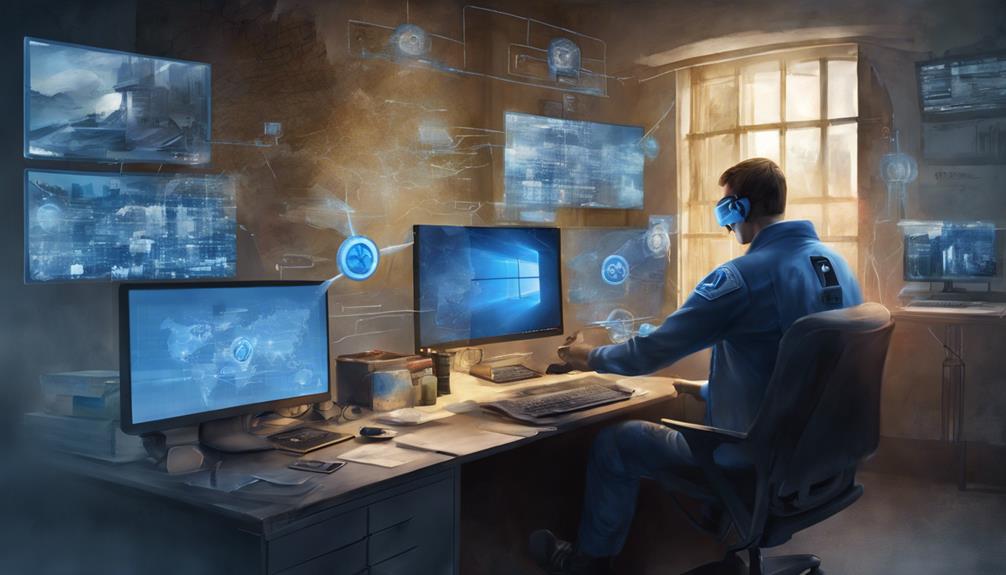Arlo cameras can be vulnerable to hackers due to weak passwords and outdated firmware. Hackers use methods like phishing and malware to gain unauthorized access. To protect your camera, update firmware regularly, use strong passwords, enable encryption, and consider two-factor authentication. Unauthorized access risks include privacy breaches and misuse of footage. Implement robust security measures, monitor camera activity, and prioritize user security guidelines. Arlo cameras offer features like two-factor authentication, firmware updates, and cloud storage encryption. By fortifying security and privacy settings, you can enhance the protection of your camera system against potential threats.
Key Takeaways
- Enable two-factor authentication for added security.
- Regularly update firmware to patch vulnerabilities.
- Use strong, unique passwords to prevent unauthorized access.
- Implement encryption protocols to safeguard privacy.
- Monitor camera activity and settings for any suspicious behavior.
Common Vulnerabilities in Arlo Cameras
Arlo cameras are prone to security risks stemming from common vulnerabilities such as weak passwords and outdated firmware. These vulnerabilities can make Arlo cameras an easy target for hackers looking to gain unauthorized access. Default settings may further exacerbate this risk, leaving the devices vulnerable to exploitation.
Without proper encryption, the footage captured by Arlo cameras could be intercepted, compromising user privacy and security. To enhance the security of Arlo cameras, users should consider implementing two-factor authentication, which adds an extra layer of protection beyond just a password.
Regularly updating the cameras with the latest security patches and firmware is also vital in mitigating potential risks. Failure to do so could expose Arlo cameras to exploitation by hackers, leading to potential breaches of sensitive data or even unauthorized control over the device.
Understanding Hacker Methods

Hackers employ various sophisticated methods, including brute force attacks and phishing emails, to target security vulnerabilities in surveillance cameras. By exploiting weaknesses in smart home devices like Arlo cameras, hackers can compromise the privacy and safety of users. Understanding the techniques hackers use is essential in safeguarding against potential security issues.
| Hacker Methods | Description |
|---|---|
| Brute Force Attacks | Automated attempts to guess passwords by trying numerous combinations. |
| Phishing Emails | Deceptive messages aiming to trick users into revealing sensitive information. |
| Malware Injection | Introducing malicious software to exploit vulnerabilities in the camera system. |
| Vulnerability Exploitation | Identifying and utilizing weaknesses in the camera's software for unauthorized access. |
To protect your Arlo cameras, it is important to stay informed about these hacker methods and take proactive measures to secure your devices. Regularly updating firmware and implementing additional security protocols can help mitigate the risks associated with vulnerability exploitation and maintain the safety of your smart home environment.
Importance of Firmware Updates

Regular firmware updates for Arlo cameras are essential for maintaining the security of the system. These updates often contain critical patches that address known vulnerabilities, safeguarding the cameras against potential hacking threats.
Neglecting firmware updates can expose Arlo cameras to exploitation by malicious actors, emphasizing the significance of staying up to date with the latest firmware releases.
Firmware Security Importance
Maintaining the security of Arlo cameras hinges greatly on the timely implementation of firmware updates. Consumer Reports found that regularly updating the firmware of Arlo cameras is a best practice to guarantee protection against potential security breaches.
Firmware updates are crucial as they often include patches for known vulnerabilities that hackers could exploit. It is highly unlikely for outdated firmware to offer strong security, leaving Arlo cameras susceptible to hacking and unauthorized access.
Arlo consistently releases firmware updates to enhance security and shield against emerging threats. By keeping the Arlo camera firmware up to date, users take a proactive measure in safeguarding their devices.
Neglecting firmware updates can expose Arlo cameras to risks, underscoring the importance of prioritizing firmware security. Users should remain vigilant and promptly install firmware updates to fortify the security of their Arlo cameras against evolving cyber threats.
Updating for Protection
Ensuring the timely implementation of firmware updates is vital for enhancing the security of Arlo cameras and protecting them from potential vulnerabilities and cyber threats. Arlo regularly releases firmware updates to address security issues and enhance the camera's defenses.
By updating the firmware, users can make sure that any known security flaws are patched, reducing the risk of unauthorized access. Failure to update firmware leaves Arlo cameras susceptible to exploitation by hackers seeking to compromise security.
Hackers could potentially gain access to the camera feed or even control the device remotely if updates are not installed promptly. Regularly checking for and installing firmware updates can greatly improve the overall security of Arlo cameras against potential threats.
It is important to take responsibility for updating the firmware oneself, as failing to do so could create false security in the belief that someone else will take care of it.
Strong Password Practices

Implementing strong password practices is essential for enhancing the security of your Arlo cameras and protecting them from potential hacking threats. Even though it may seem simple, using strong, unique passwords can greatly reduce the risk of unauthorized access.
A strong password should consist of a combination of uppercase and lowercase letters, numbers, and special characters to bolster security. Avoiding common or easily guessable passwords like '123456' or 'password' is vital to safeguard your Arlo cameras from hacking attempts.
Regularly updating and changing your passwords adds an extra layer of defense against unauthorized access, helping to keep your security system secure. Additionally, enabling two-factor authentication for your Arlo cameras can further enhance security, making it harder for hackers to breach your devices.
Enabling Encryption on Arlo Cameras

Arlo cameras provide users with the option to enhance security by enabling encryption for safeguarding video streams and data transmission. Encryption is an essential feature that helps prevent hackers from intercepting and accessing footage. Arlo cameras offer AES encryption, a widely recognized and strong encryption standard. Users can easily activate encryption on their Arlo cameras through the settings in the Arlo app.
By activating encryption, an additional layer of security is added to protect your Arlo camera system. This extra security measure ensures that your video streams and data are securely transmitted, reducing the risk of unauthorized access. Enabling encryption on your Arlo cameras is a proactive step towards safeguarding your privacy and ensuring that your footage remains secure from potential cyber threats.
It is recommended to always keep encryption enabled to maximize the protection of your Arlo camera system.
Two-Factor Authentication for Security

Two-factor authentication is an important security measure that adds an extra layer of defense to your Arlo cameras.
Setting up two-factor authentication involves enabling it in the Arlo app or web portal to enhance the protection of your camera system.
The benefits of two-factor authentication include requiring a unique code in addition to passwords, helping prevent unauthorized access to your camera feeds.
Importance of Two-Factor
Improving the security of Arlo cameras is essential, and one effective measure to achieve this is through the implementation of two-factor authentication. This security feature adds an extra layer of protection by requiring a second form of verification, such as a code sent to a trusted device, in addition to your password.
Arlo cameras support two-factor authentication to prevent unauthorized access to your camera feeds and settings, reducing the risk of hackers gaining control of your devices. By enabling this feature, you can greatly enhance the overall security of your Arlo cameras and safeguard against potential hacking attempts.
Two-factor authentication is a recommended security measure to protect your privacy and uphold the integrity of your Arlo camera system. It is a proactive step that every Arlo camera user should consider to strengthen the security of their devices and prevent unauthorized intrusions.
Setting up Two-Factor
When enhancing the security measures of your Arlo camera system, implementing two-factor authentication is an essential step to fortify your defenses against potential security breaches. Two-factor authentication adds an additional layer of security by requiring users to verify their identity with a second form of verification, such as a code sent to their phone. This extra step helps prevent unauthorized access to your Arlo camera account, reducing the risk of hackers gaining control. Setting up two-factor authentication can greatly enhance the security of your Arlo cameras, providing peace of mind knowing that your system is better protected. By enabling this feature, you can better safeguard your Arlo camera system from potential threats. Below is a table illustrating the importance of setting up two-factor authentication:
| Benefits of Two-Factor Authentication | Description | Enhanced Security |
|---|---|---|
| Adds an additional layer of security | Requires a second form of verification | Prevents unauthorized access |
Benefits of Two-Factor
Enhancing the security of your Arlo camera system through the implementation of two-factor authentication offers a strong defense against potential security breaches. Two-factor authentication adds an extra layer of security by requiring a second form of verification, such as a code sent to your phone.
Here are four benefits of utilizing two-factor authentication for your Arlo cameras:
- Increased Security: It greatly reduces the risk of unauthorized access to your Arlo cameras even if your password is compromised.
- Optional Feature: Arlo offers two-factor authentication as an optional feature to enhance the security of your camera system.
- Comprehensive Protection: By enabling two-factor authentication, you can protect your camera feeds, recordings, and settings from potential hackers.
- Proactive Security Measure: Utilizing two-factor authentication is a proactive measure to safeguard your privacy and prevent unauthorized access to your Arlo cameras.
Risks of Unauthorized Access

Unauthorized access to Arlo cameras poses a significant risk if proper security measures, such as strong passwords and firmware updates, are not implemented. Weak or default passwords can make Arlo cameras an easy target for hackers seeking unauthorized entry.
Regularly updating the camera's firmware and using unique, complex passwords are vital steps to reduce the risk of unauthorized access. The consequences of unauthorized access can be severe, including privacy breaches, unauthorized monitoring, or misuse of captured footage.
To enhance protection, additional security measures like two-factor authentication can be employed. It is essential for Arlo camera users to be vigilant and proactive in safeguarding their devices against potential threats.
Protecting Against Potential Threats

To safeguard your Arlo cameras against potential threats, it is important to implement robust security measures, prioritize privacy settings, and adopt effective anti-hacking strategies.
By following these key points, users can fortify the protection of their camera systems and prevent unauthorized access.
Enhancing security features and staying vigilant are essential practices to guarantee the safety and integrity of your Arlo cameras.
Security Measures Overview
Arlo cameras implement robust security measures to fortify protection against potential threats and unauthorized access. These measures include:
- Two-Factor Authentication: Arlo cameras offer enhanced security with two-factor authentication, adding an extra layer of protection by requiring users to verify their identity through a second method.
- Firmware Updates: Users can strengthen security by regularly updating firmware on Arlo cameras. These updates help patch vulnerabilities and guarantee the system is equipped with the latest security features.
- Secure Cloud Storage: Arlo cameras support secure cloud storage, making sure that footage is safely stored and encrypted to prevent interception by unauthorized parties.
- Motion Detection Alerts: Enabling motion detection alerts on Arlo cameras can help users stay informed of any suspicious activity in real-time, enhancing security by providing immediate notifications of potential threats.
Privacy Settings Importance
Enhancing privacy settings on security cameras is vital for safeguarding against potential threats and maintaining the integrity of data transmission. Arlo cameras provide users with advanced privacy controls, empowering them to manage access and permissions effectively.
By enabling two-factor authentication, users add an extra layer of security to prevent unauthorized access to their cameras. The encrypted connections utilized by Arlo cameras ensure that data transmission remains secure, minimizing the risk of interception by hackers.
Furthermore, regular firmware updates from Arlo play an essential role in addressing security vulnerabilities and enhancing protection against cyber threats. Adjusting privacy settings on Arlo cameras not only safeguards against potential hacking incidents but also helps uphold the confidentiality of captured footage.
Users must take advantage of these privacy features to bolster the overall security of their Arlo cameras and guarantee the safety of their data.
Anti-Hacking Strategies
Implementing robust security measures is crucial in safeguarding Arlo cameras against potential hacking threats. To protect your Arlo cameras from unauthorized access, consider the following anti-hacking strategies:
- Regular Firmware Updates: Keep your Arlo cameras up to date with the latest firmware releases to patch any security vulnerabilities that hackers could exploit.
- Strong Passwords and Two-Factor Authentication: Use unique and complex passwords for your Arlo accounts and enable two-factor authentication for an added layer of security.
- Secure Wi-Fi Network: Guarantee your home Wi-Fi network is secure by using a strong password and encryption protocols to prevent hackers from intercepting camera feeds.
- Disable Unnecessary Remote Access: Limit remote access to your Arlo cameras to trusted devices only, reducing the risk of unauthorized entry into your camera system.
User Guidelines for Arlo Camera Security

Consistently prioritizing user security measures is essential for maintaining the integrity and privacy of your Arlo camera system.
To enhance security, enable two-factor authentication on your Arlo camera account. This additional step adds an important layer of protection against unauthorized access.
Keep your Arlo cameras secure by regularly updating their firmware. These updates often include important security patches that safeguard your system against potential vulnerabilities.
When creating passwords for your Arlo camera account, make sure they are strong and unique. Avoid easily guessable passwords to deter hackers from gaining unauthorized entry.
Stay vigilant by monitoring your Arlo camera activity for any signs of unusual behavior, as this could indicate a security breach.
Additionally, refrain from accessing your Arlo camera feeds through public Wi-Fi networks, as they may pose increased risks of hacking attempts.
Final Verdict: Are Arlo Cameras Safe?

The overall security of Arlo cameras is commendable, supported by a robust framework of encryption protocols, regular firmware updates, and advanced security features.
When evaluating the safety of Arlo cameras, it is essential to take into account the following key points:
- Regular Firmware Updates: Arlo's consistent updates guarantee that potential vulnerabilities are patched promptly, enhancing the overall security posture of the cameras.
- Two-Factor Authentication: By offering two-factor authentication, Arlo provides an additional layer of security, making it harder for unauthorized users to gain access to the devices.
- Robust Cloud Storage Encryption: The use of strong encryption for cloud storage safeguards user data and footage, minimizing the risk of breaches and unauthorized access.
- Built-In Security Features: Arlo cameras incorporate advanced security measures like motion detection and activity zones, enhancing monitoring capabilities while ensuring user privacy is maintained.
Taking these factors into account, Arlo cameras are well-equipped to protect user information and provide a secure monitoring experience.
Frequently Asked Questions
Are Arlo Cameras Safe From Hackers?
Arlo cameras have vulnerabilities that pose potential hacking risks. To enhance security, users should update software, use strong passwords, and enable two-factor authentication. Proactive measures are essential to prevent unauthorized access.
Can Someone Else Access My Arlo Camera?
Unauthorized access to Arlo cameras is unlikely when security measures are diligently maintained. Robust login requirements, two-factor authentication, and regular firmware updates bolster protection. Users can further enhance security by utilizing strong passwords and enabling two-factor authentication.
How Safe Is Arlo Camera?
Arlo cameras prioritize security by offering robust encryption, frequent firmware updates, and two-factor authentication. Renowned for privacy protection, Arlo employs advanced encryption for cloud storage, making it a trusted choice for homeowners seeking a secure smart home security solution.
How Do I Know if My Arlo Has Been Hacked?
To determine if your Arlo camera has been compromised, vigilant monitoring is paramount. Look for deviations in settings, abnormal activity, or foreign connections. Swiftly address any suspicions by fortifying passwords, updating software, and implementing robust security measures.
Conclusion
To sum up, Arlo cameras are vulnerable to hackers if not properly secured. It is essential to keep firmware updated, use strong passwords, and enable encryption to protect against unauthorized access.
One interesting statistic is that 81% of hacking-related breaches are due to weak or stolen passwords.
By following best practices for security, users can minimize the risk of their Arlo cameras being compromised.









